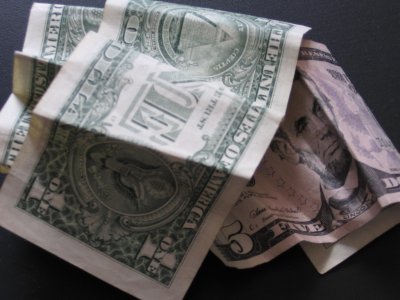Updated: January 1, 2011
If you consider yourself a man of the world, then you must like British humor. If you like British humor, you should be watching Live at the Apollo. If you do, then you may have stumbled upon a nice sketch, where the comedian debates Bill Gates' wealth. The comedian asks a handful of legitimate question any sane person would ask: What would happen if Bill stacked all his money under a mattress? The man then discusses what would happen if Bill jumped off his mattress, what with all them shekels piled underneath. How big of a fall would that be? And what about the interest rate?
Indeed, legitimate questions them all. In this article, I will quantify this simple human envy for Bill's wealth. How high would the money pile really be? How much time would a person take to jump off it and reach the ground? Could interest rate make up for the descent, creating a situation where the jumper would never reach the bottom, truly defying the gravity?

The bold claim
The pile would be 10 km high and it would take you 18 minutes to reach the ground. The interest rate would make the pile grow so quickly it would compensate for your fall, making you defy the gravity. Is this true? Or just rather funny? Have the British unraveled a mystery that has eluded humanity for so long?
Bill's wealth, a king size mattress, and US denomination
We will assume Bill sleeps on a bed 225x225 cm. For the sake of simplicity, a USD1,000 note measures 15x5 cm. This means that a single layer of notes carefully stacked under Bill's bed would be worth fifteen notes longitudinally, 45 notes transversely, a total of 675 notes or USD675,000 dollars. Not bad.
Now, we will assume you can stack 100 notes in a pile one cm thick. This means that there would be 675 million dollars in a pile 10 cm high. Bill's net worth is about 80 billion dollars. In order words, his entire stack would rise approx. 11.85 meters above ground. If you need help with the above calculation, do let me know. All right, let's do the math. 80 billion divided by 0.675 equals 118.5. So we have 118.5 10-cm stacks, or 11.85 meters. Feeling any better?
11.85 meters is not that much, when you think about it. Still, it could be fatal if you landed on concrete.
What if we substitute 1000-dollar notes for one-dollar notes?

All right, it becomes interesting. Our pile now grows to a staggering 11.85 km! This means you would officially reach the stratosphere. Without adequate protection, you would die of cold and the lack of oxygen and the winds would topple the pile. But never mind that.
The money jump
If you leap, you lose contact with the pile. So even if it's growing due to interest rate, you would not be affected. But let's assume that you would. Let's assume that interest rate would somehow make your fall longer.
Given a 10% rate annually, Bill's money is making a handsome eight billion dollars a year or roughly 1.185 meters in height. It's a 3.24 meter growth every day or approx. 0.22 cm every minute.
On the other hand, a free-falling person reaches the terminal velocity of about 250 kph or 70 meters/sec. Falling from a 12 km money pile would take only about 170 seconds to reach the ground. 170 seconds, three minutes. In this time, your pile would grow by a meager 0.6 cm, not enough to counter the force of the gravity.
The only way you could do that was by making your money pile grow by more than 70 meters every second. 70 meters of pile in one-dollar notes translates into roughly 470 million dollars. This means that Bill's wealth would grow by 40.7 trillion dollars every day or almost 15,000 trillion dollars annually. Compared to his original worth, this is a handsome 18.8 million percent interest.

At the end of the year, the pile would have grown from 11.85 km to roughly 2.2 million km, seven times the distance to the Moon. The only way to escape gravity. Not bad. Well, the truth is, the farther you got away from planet Earth the less of a gravitational pull. You may break even with far less.
Actually, it gets worse. The above calculation only works for a static annual interest rate. We might have exponential interest rate. The money pile could actually accelerate. And one day, break the sound barrier. Or worse. It could go near-speed-of-light and then you'd have time-space effects, with special gravity affecting interest rate in unprecedented ways. Time would change. Uh-oh, it gets complicated. Damn.
So the simple answer is: no, you can't beat gravity. Not even Bill Gates.
Conclusion
Bill Gates is one of the richest people in the world. And his money pile would make for one really, really fat mattress. But even the inventor of DOS, the man behind Windows, cannot defeat the basic laws of physics that easily. And there's some simple comfort in that. Because the day humans start using nothing but financial gain to fight off the forces of the universe, it's going to be a bad day for us all.
What more, Live at the Apollo had it wrong. The figures were embellished, for the sake of dramatic effect. But Bill's pile does tower mightily high. Created from one-dollar bills, it would skyrocket into stratosphere and make for a very lethal prize. But it would not stop a happy jumper from deficit and a somewhat permanent Chapter 13.
Well, there you go, all your questions answered. Finance, interest rate, terminal velocity, you name it. Dedoimedo strikes again, with all the beauty and glory of a Ford Focus plowing into a kindergarten. Have fun. P.S. Both the dollar image and the jumper are US Government work and in public domain.
Cheers.